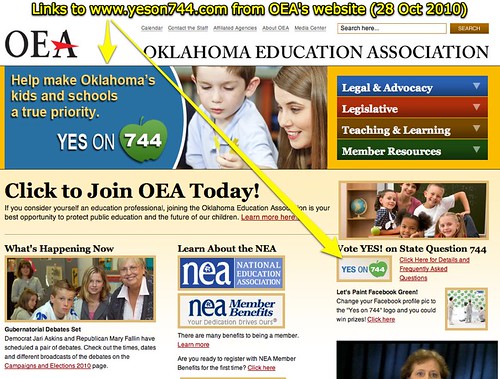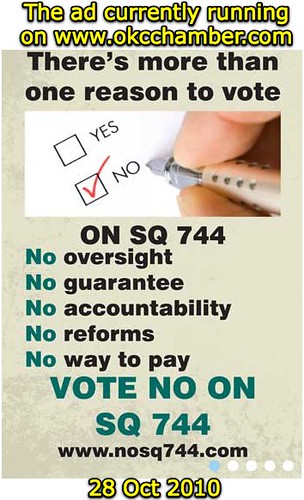It’s almost election time, and Oklahoma voters statewide will be voting on “state question 744” next week on November 2nd. Given the HUGE importance and impact of this proposed state constitutional amendment to the educational future of our state, it seems quite odd the “backstory” to this initiative has not (to my knowledge) received more mainstream press coverage. At issue is how much Oklahomans spend per pupil on public education. This annotated map from the website YesOn744.com illustrates the regional comparisons. As Oklahomans we’re dead last among all the other U.S. states we border in public education spending.

According to the current English WikiPedia entry for 2010 Oklahoma State Elections:
State Question 744 would amend the Oklahoma Constitution by adding a new article: Article 13-C – Amount of money the State provides to support common schools.
The proposed Constitutional amendment would mandate that the Oklahoma Legislature spend no less than the average amount spent by neighboring states on common education on an annual, per-student basis. Common education refers to pre-kindergarten through high school; the surrounding states are Missouri, Texas, Kansas, Arkansas, Colorado and New Mexico. If the surrounding-state average ever declines, the legislature would be required to spend the same amount as it did the year before. The measure requires that increased spending begin in the first fiscal year after its passage. It requires that the surrounding state average be met in the third fiscal year after passage.
The measure does not raise taxes or provide a funding source for the new spending requirements.
I would like to know more about the “backstory” of state question 744. In this post, I’m going to share what I know at this point, some relevant links, and a little analysis. As always, I invite you to comment and share links on this post related to this question and these issues.
The gist of what I’ve heard from others in our church and community is that big dollars from outside the state, principally from the National Education Association, have poured into Oklahoma and continue to pour in to support passage of 744. According to BallotPedia:
SQ 744 was initiated by the Oklahoma Education Association (OEA) after the union lost a lawsuit seeking to increase education funding.
The website for the Oklahoma Education Association prominently features images and links asking for support of SQ 744. The website YesOn744.com is the primary advocacy site which as been created for the ballot initiative.
The OEA website includes a Facebook-posted video of OEA President Becky Felts, explaining in sixty seconds why Oklahoma voters should approve SQ 744. The bottom line is that Oklahoma students, because our schools and public education system are comparatively underfunded relative to our neighboring states, do NOT receive the same educational opportunities as students in our neighboring states. I agree with her. I would not have said “vote for 744 so our students can have the right books in class,” however. I’d instead talk about our need for a 21st century education which prepares students for success in our globalized workforce as well as society. Like Dr. Tim Tyson in his outstanding presentation last week in the K-12 Online Conference, I’d reference the educational success story of Finland and talk about the vital importance of recruiting our top students to serve as professional teachers. If we want a world class educational system, and we want to improve what we’ve got, we have to CHANGE some things. Here in Oklahoma, that starts with PAYING teachers more and funding our schools better. My son attends Oklahoma City Public Schools, and we’re thrilled MAPS is funding some improvements. We’ve got a long way to go, however, and mandating increased educational funding is an important part of “the way forward” for improving education in Oklahoma.
Opponents of SQ 744 have formed the “The One Oklahoma Coalition” and created the website, www.nosq744.com. Oklahomans for Responsible Government sponsor the website www.stop744.com. That website lists the following on its fact sheet:
The OEA’s FAQ on SQ 744 says it will cost $850-million dollars.
There is no funding mechanism for SQ 744. That means money will either have to be shifted out of other agencies or funded through tax increases.
House Fiscal staff says paying for SQ 744 (which it estimates will be $850-million) only through spending cuts will require a 20% cut from each agency.
House Fiscal staff says paying for SQ 744 through a tax increase would raise income taxes by 34% or sales taxes by 38%.
There is nothing in SQ 744 that mandates the money be spent in the classroom. In fact, the OEA says it will be local administrators that decide what to do with the windfall.
According to the report, “Blueprint for Transparency A Review of Oklahoma School District Websites” by Oklahomans for Responsible Government:
Oklahoma spends over $4-billion on K-12 education when federal, state and local dollars are factored in.
An $850 million increase in education, if that was a PER YEAR increase, would certainly be substantial. Interestingly, the OEA FAQ webpage for 744 referenced on the Stop744 “factsheet” does NOT include the statistic “$850 million.” In reference to the question, “How quickly will schools see funding if SQ 744 becomes law?” it states:
SQ 744 provides for a three-year phase-in period, which means that it will not be fully implemented until the 2014-2015 school year. This will allow us to properly plan and prioritize our schools. We can begin now to reinvest in our schools and focus on the future, leaving behind a positive legacy all Oklahomans can be proud of.
In response to the more challenging question, “How do we pay for SQ744?” the YesOn744.com site authors offer a variety of important points.
We could cut special interest tax breaks. They write:
We can afford SQ 744 if we end billions in special interest tax breaks. Last year, the legislature gave away over $2 billion dollars in special interest tax breaks for pork projects that had no effect on our economy and that created virtually no jobs for our citizens. Not surprisingly, career politicians and special interests haven’t offered to cut waste, fraud, abuse and risky projects. We can start by eliminating millions in wasteful spending, like giving $18 million to a rocket ship company that went bankrupt or giving away $32 million to a gimmick airline that never flew a single plane.
In September 2010, Oklahoma State Sen. Tom Adelson wrote in his article for NewsOK, “SQ 744 affordable if we change special interest treatment:”
Every year, every session your Oklahoma Legislature ignores hundreds of millions of dollars of potential revenue — money that should be invested in health, education, transportation and public safety — for favored businesses and “clients.” For example, investor and corporate tax breaks exploded from $50 million in 2006 to over $210 million in 2008. In addition to that staggering amount, the oil and gas industry has received another $350 million-plus in tax giveaways since 2004. That’s over a half-billion dollars that could be invested in our schools.
This is something I’ve been wondering about for a long time, ever since our family moved to Oklahoma four years ago from Texas. My dad grew up in Wyoming, and his best friend from school growing up in Powell now serves in the Wyoming legislature. He should know the answer to this question. Why has Wyoming, a natural resource-rich state, been able to so ably-fund its educational system as well as other elements of state government– and Oklahoma seems to be gasping for breadth not only in education funding but in every state agency? Oklahoma is natural resource rich too. I don’t have the evidence, but I have a strong suspicion I know the answers: Corruption, special interest tax breaks, and a failure of Oklahoma elected officials to act in the public interest.
On our state license plates we have the slogan, “Oklahoma is OK.” I’ve had a BIG problem with that, and I still do. There are lots of WONDERFUL things about Oklahoma, but in generally I’m not satisfied with “OK.” I want excellent, for my children and my grandchildren. I’m a part of the Oklahoma Creativity Project‘s education committee in part because I want to advocate for positive change in our Oklahoma schools. Their website says nothing about SQ 744, and I know they are consumed with preparations for next month’s World Creativity Forum here in Oklahoma City. I think this is a missed opportunity, however. I’m betting SQ 744 is very divisive among Creative Oklahoma member organizations, which include some heavily invested in our oil and gas industry. The politics of nonprofits and coalitions are frequently interesting.
The backstory of how SQ 744 came to be on the ballot, and what organizations are funding its advocacy (like YesOn744.com) are not a mystery. What DOES remain a mystery to me are the individual big funders behind The One Oklahoma Coalition (@oneokcoalition on Twitter) and www.nosq744.com. As of today, the coalition member page lists 110 organizations. These include groups like the Greater Oklahoma City Chamber of Commerce, The State Chamber of Oklahoma, and the Tulsa Metro Chamber of Commerce. This is the banner image currently running first on the homepage of the Greater Oklahoma City Chamber of Commerce today:
The first three claims on this negative advertisement are blatantly false. No oversight or accountability? What do the authors of this campaign think the Oklahoma State Department of Education is? Or our current elected officials, as well as the offices they hold? Our republican form of government, in which we elect officials to make decisions, pass laws, and run our government is the “check and balance” on all state spending. It is ridiculous to portray this measure as one which “no one” will be able to control, oversee, and regulate. That’s simply false. Overseeing and regulating state spending is what state officials, both elected and appointed, do now and will continue to do after the election.
Incidents of obfuscation when it comes to SQ 744 are not limited to organizations, however. “Oklahoma Chief of Education Strategy and Innovation,” Kathy Taylor, is telling the public passage of SQ 744 “…could force a reduction in funding of other services kids must have to succeed in life and help our economy grow.” What our legislature chooses to do, and HOW our elected officials choose to pay for SQ 744, is an entirely open question. Would the citizens of Oklahoma stand for a huge increase in personal income taxes, as many fear-mongering opponents of 744 claim? I doubt it. Yet that’s the “fear card” being played by many in the anti-744 gang. Consider the words of Roy Williams, President and CEO of the Greater Oklahoma City Chamber, in the right sidebar of the NoTo744.com coalition members page:
The Greater Oklahoma City Chamber has been active in supporting education, including more funding for years, but to tie funding to an arbitrary average, and either force funding education at the expense of other vital programs or by enacting huge tax increases is not the way forward.
“An arbitrary average?” Roy, exactly what would you consider to be a “non-arbitrary average?” The issue is whether we want to spend the money we need to educate our children well for the 21st century. To date, Oklahoma has been doing a poor job of that relative to our surrounding states. It is NOT required in this proposed state Constitutional amendment that programs be cut or taxes raised. There is another way to balance the budget, and it’s called: Finding other sources of revenue! I’m sure the corporations and individuals benefiting now from huge tax breaks don’t want those to end, and don’t want to pay more taxes any more than individuals in our society do. It’s critical that we subject those tax breaks to public scrutiny, however, and avoid the kind of waste YesOn744 documents. Consider the way Oklahoma legislators stack up in pay for their part time elected jobs for the state:
Oklahoma $38,400 per year
Missouri $35,915 per year
Colorado $30,000 per year
Arkansas $15,362 per year
Kansas $88.66 per day ($7,316 on 88 day session)
Texas $7,200 per year
New Mexico $0 per year
Those numbers alone won’t add up to the dollars needed to fund 744, but combined with other tax changes the money CAN be found.
As a state, Oklahoma is NOT poor relative to many other places. The majority of anti-744 press coverage and advertising I’ve heard to date follows (unfortunately) what Senator Adelson described in September:
The One Oklahoma Coalition tells us we can’t afford State Question 744. The coalition resorts to scare tactics such as prison closure and road collapse while ignoring hundreds of millions of savings that could be secured by simply ending special interest treatment through the tax code and redirecting that money to education. Passage of State Question 744 will require the Legislature to do just that. And it is high time we did.
I’d like to know more about the backstory of the anti-SQ 744 lobby, because I don’t think those folks should hide in the shadows. We need MORE democracy in this nation, not less– and it should start locally. Work by groups like the Sunlight Foundation to promote governmental transparency and better civic awareness are desperately needed not only at the federal level, but at the state level as well.
Do we need to pay our teachers and fund our educational system in Oklahoma much better than we do today? Yes, absolutely. Would passage of SQ 744 challenge our elected officials to more carefully scrutinize the tax breaks given to special interest groups, and reclaim much of that money for the public good? I hope so.
Things are heating up in Oklahoma in advance of November 2nd. This tweet today from @YESon744 provides a example:
One of the most important questions which IS being raised by the anti-744 cadre involves EDUCATION REFORM. Do we need it in Oklahoma? Yes, absolutely! It would be inappropriate for the authors of SQ 744 to have put provisions for educational reform into that proposal, however. We’re electing a new state superintendent for education this year, who will replace our current superintendent who has served for the past 21 years, since 1988. It’s going to be a GREAT time to not only discuss educational reform in Oklahoma in 2011, but also implement it. That will be particularly true if our educational system receives increased funding comparable to that of our surrounding states.
Don’t buy into the fear mongering and misleading statements of the anti-744 coalition. If you’re an Oklahoma voter, vote YES for state question 744 on November 2nd. Our children will thank us, and so will their teachers… as well as their future employers, who need a world-class educated workforce ready for the challenges of the 21st century.
Technorati Tags:
education, oklahoma, policy, politics, question, reform, state, 744, sq, sq744, nea, oea






Comments
8 responses to “The backstory of Oklahoma State Question 744”
Wes,
Once again, you have really done a ton of research on this important amendment. I think that the ‘hot tempers’ sometimes flare for people who have not even really done much research into the facts.
Great Article!,
~Paul
My name is Walton Robinson and I am the communications director for the ‘YES ON 744’ campaign. I am happy to give you background on how SQ 744 got on the ballot.
The story actually begins in 1990s with the passage of HB1017.
Feel free to contact me at: wrobinson@yeson744.com.
Thanks!
Walton Robinson
I heard some people this morning say that 744 would create a commission outside the control or influence of the Oklahoma State Department of Education, which would oversee the disbursement of funds mandated by this Constitutional amendment. Nothing about that is in the language I found online, or that voters will approve. Is this allegation true? Where can I find the language of the Constitutional change which addresses this?
Where do the two candidates for State Superintendent stand on SQ 744? There is not guarantee that treatment of special interests will stop if 744 is passed. Are we just supposed to trust the same government officials to figure out how to pay for 744 if it passes?
Shannon: The issues of government accountability and corruption are huge ones. 744 can’t solve those issues, but it takes an important step forward in MAKING our legislature fund education at an equitable level compared to our surrounding states. It will be up to the legislature to determine the funding sources – and you are right to point out we need to be wary of their actions. The back room tax cuts to corporate special interests are a big place where we can find these dollars, and we need to be vocal so that process can be an open and transparent one. We should already be funding education at equitable levels to our neighboring states, but we aren’t. Without 744, Oklahoma legislators won’t. Our kids deserve and need a world class education, and 744 lets us increase funding specifically for education in a way our reps won’t without our help.
Shannon: In response to your question, the candidates are split. According to this October 20th News6 article, Janet Barresi is against 744, Richard Cooper is for it, and Susan Paddack isn’t stating her position.